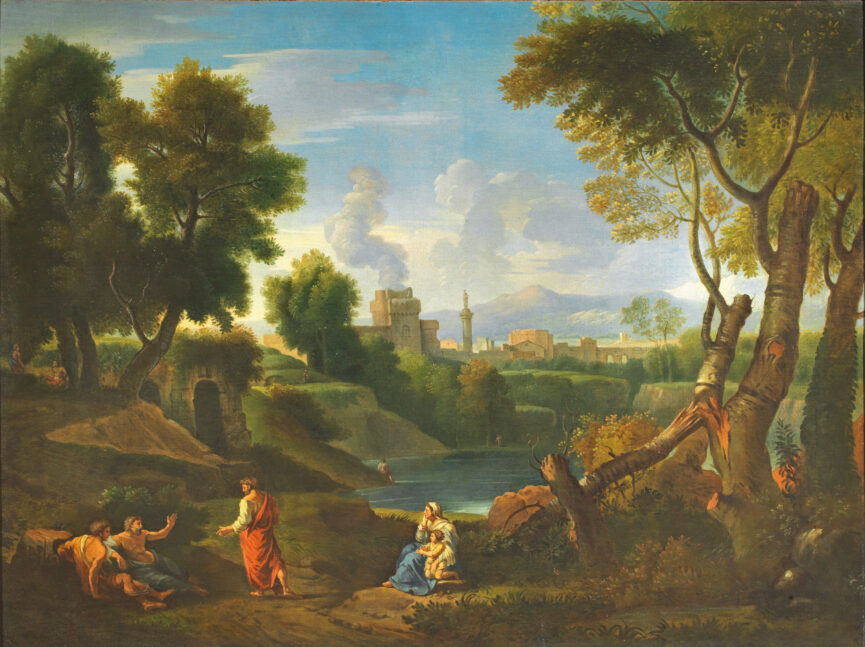Attributed to JAN FRANS VAN BLOEMEN called ORIZZONTE
(Antwerp 1662 - Rome 1749)A Classical Landscape with figures reclining beside a river, a grotto entrance to the left, a castle be-yond with a monumental column topped by a statue in the distance
Oil on canvas: 37 3/8 x 49 5/8 in. 95 x 126 cm.
This gentle, lyrical landscape bears many of the hallmarks of the work of Jan Frans van Bloemen, known as Orizzonte. In addition to its mood of classical harmony, there are several details which stand out from other works by the painter. The grotto entrance to the left features in several works illustrated in Busiri-Vici’s monograph on the artist, such as under nos.118 and 119, illust. 42 and 43 as Interior views of the Colisseum and the preparatory drawing for these, no.29d illust.43a. The castle in the distance is a familiar motif found in any number of works by the artist as it focuses the eye on the recession of details, as does the giant column with the statue. Orizzonte’s dotted brushwork in the foliage is also evident here, while the fluidly executed figures may well have been contributed by one his usual staffage painters, Pompeo Batoni, Sebastiano Concaor Placido Costanzi.
Alain Jacobs, in the Macmillan Dictionary of Art, states that “Considered a great artist by his contemporaries, Orizzonte produced some of the finest classical landscape painting in Rome during the first half of the 18th.century.” His style was a fusion of the Dutch-Italianate painters active in Rome in the mid seventeenth century, and the classical Roman painters, such as Poussin and Dughet, of the same period. Jacobs refers to “a calmer and more synthetic artistic vision” around 1730, “some features of which were borrowed directly from Poussin” so this could be an alternative dating for our painting. Out of these influences he fashioned a technique and a vision which breathes a serenity peculiar to the artist. Every landscape he painted evinced a love for the campagna, its shifting lights and shadows, and the radiance of its early morning and evening skies. His mastery of recession and the bluish horizons which terminate his views gave rise to his pseudonym Orizzonte. As the staffage in the artist’s works was often supplied by Carlo Maratti, Placido Costanzi or Pompeo Batoni, it is possible that the figures in our landscape could be by one of these painters.
Although extremely popular among Roman patrons, Van Bloemen was only admitted to the Accademia di San Luca at the age of eighty, as a result of a prolonged disagreement with the institution. We know he was in Rome by 1693, the year he married there, and his Dutch roots were reflected in the choice of Caspar van Wittel, also an artistic role model, as godfather to his first child. Van Bloemen’s evocative panoramas were ideal as a means of expressing classical nobility in a picture collection, and they were soon acquired by patrons both north and south of the Alps, who hung them, like their Dughets, as serene resting points between the masterpieces of their collections. He is therefore represented in the Doria-Pamphili Gallery, Rome, at Attingham Park, Shropshire and Schloss Worlitz, near Dessau.
Van Bloemen’s broad but expressive facture sets him apart from his close contemporaries, such as Andrea Locatelli, Paolo Anesi and Gianpaolo Panini. Two of his most effective pupils were Gabriele Ricciardelli and Nicolo Bonito.

